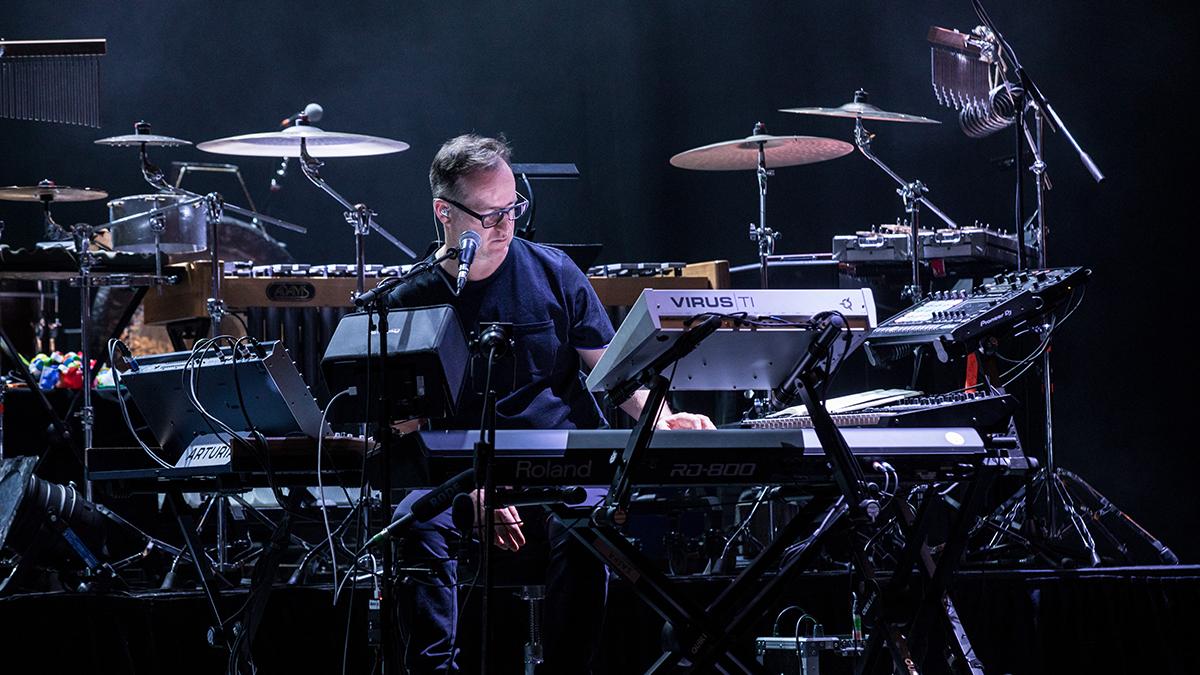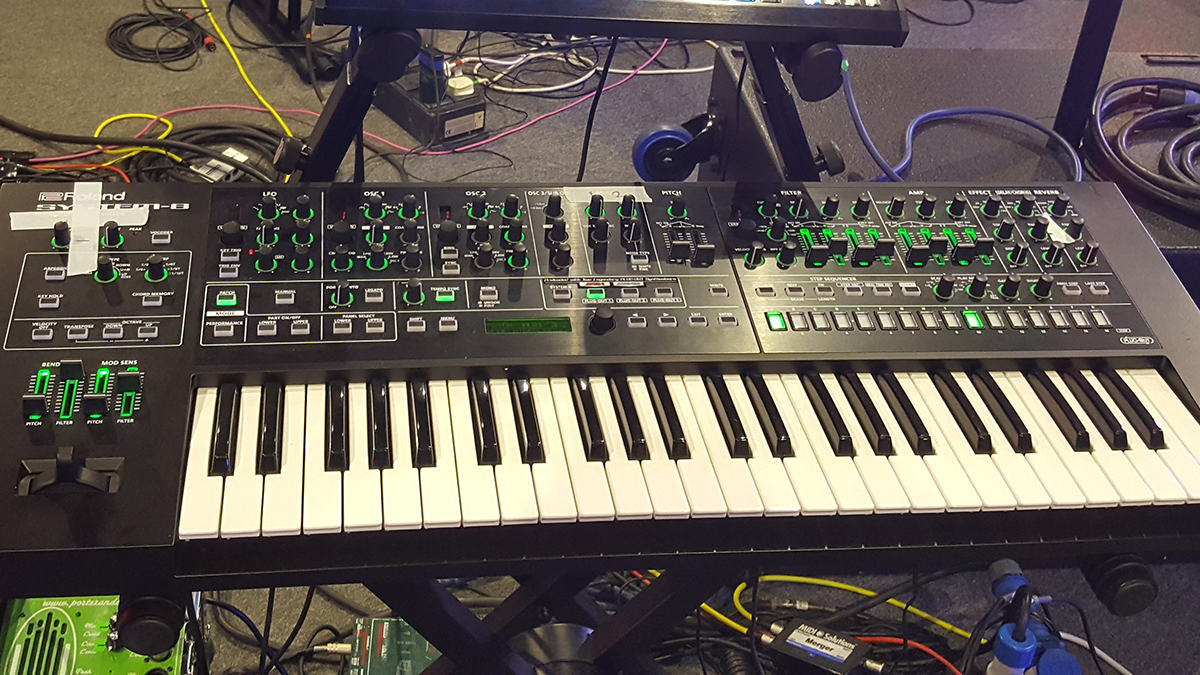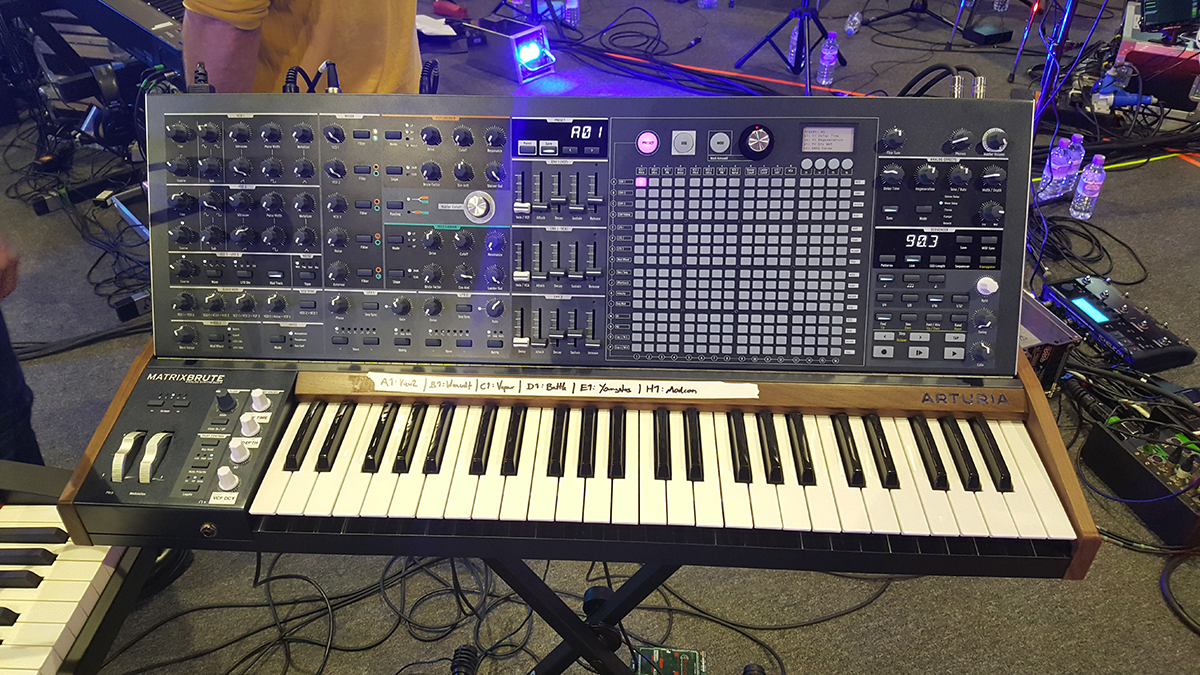In pictures: Sasha’s live setup revealed
Behind the scenes of the sold out Barbican show

Barbican-bound
Award-winning Sasha is one of the most venerated DJs on the planet. The Welshman cemented his popularity in the ‘90s and took progressive house into the mainstream with his Involver mixes and partnership with fellow Renaissance club night DJ John Digweed.
In recent years, Sasha has changed direction with the release of Scene Delete, produced in conjunction with compilation album curators Late Night Tales. Under their guidance, he was inspired by modern neo-classical composers such as Nils Frahm and Max Richter and embarked on a compelling challenge to rework Scene Delete alongside various back catalogue tracks in preparation for a live concert.
The result was re:Fracted, Sasha’s first ever live performance held at the prestigious Barbican in London. In his own words: “I love a challenge like this; it’s the kind of thing I thrive on. But at the same time, this is a big mountain to climb, it’s a massive undertaking that I’ve set myself”.
Despite the pressure of preparing for such an event, the legendary DJ/producer invited us to run through his on-stage setup during rehearsals and meet the band.

Going live
Sasha: “The Late Night Tales guys have been amazing to work with. They’re very well-connected with The Barbican and asked if I’d think about doing a live performance of Scene Delete. I told them I wouldn’t know where to start, so they told me to go and see Nils Frahm at the Barbican and the venue blew me away - as did seeing him play and merge electronics in a concert hall. It really sowed a seed, so I couldn’t really turn down being offered a gig like that.”
“We realised just doing Scene Delete wouldn’t be enough, so we started going through the back catalogue and looking at reinventing older tracks and some of my favourite remixes. Gradually, the idea came together. I’ve never played live in front of anyone before. I played the piano when I was a kid, but stopped when I was 16.”
“The moment I committed to doing it, I suddenly realised I was going to have to relearn how to play the piano. It’s expanded out more and more since then, with everyone having a separate workstation. It’s like going back to where I started, with an MPC, a JD-800 and a few other synths - it’s kind of gone full circle.”

Pioneer DJ Toraiz SP-16
Sasha: “We use this to sequence a lot of the electronic drums, hi-hats and drum fills. I love the sound of this machine.
“It has some issues in terms of the software and is not quite as advanced as an Akai, but I love the feel and sound of it and how it combines the 808 and the MPC. I grew up programming drums on an MPC before I even got into doing things on a computer, so it feels really natural to me to do drum fills and note repeats.”

Roland System-8
Sasha: “This is just a monster. You pick it up and it’s so light that you wonder how serious this machine can be, but it’s pretty damn serious.
“The System 8 has everything, but when you go into the plug-out mode it hosts a Jupiter-8 and Juno-106. It’s a really well-thought-out synth that sounds phenomenal and has a couple of really big moments in the show.”

Access Virus TI
Sasha: “This has been at the centre of our studio since the first Involver really. It’s the synth we rely on most for lead synth lines, pads and string lines.
“There’s just something about the expressiveness of its sounds. It’s got a matrix built in so you can go really deep - it’s pretty incredible what you can do with it.”

Roland RD-800
Sasha: “This is my trusty Roland piano. It’s the not the latest one because they came out with the Roland RD-2000, which I couldn’t get hold of.
“I went to the guitar centre in New York and tested every piano they had, but I just love the feel of the Roland keyboard and it’s my favourite one to play. When you play the Virus using this keyboard it becomes so much more expressive. The piano sounds are amazing and the feel of it is fantastic too.”

Arturia MatrixBrute
Sasha: “To be honest, I’ve only scratched the surface of it because we only got it as we were starting rehearsals. We’re doing a lot of our analogue sequences on it and it’s got a really unique sound.
“I can’t wait to get it in the studio, get deep into the matrix and work out how to really programme it properly. It’s a proper modular, so it’s got that dirty sound that only Brutes can have, but you can do some amazing creamy synth lines too.
“The only thing that lets it down is the effects, but we have about 10 Eventide H9s in the room, and when you put it through one of those it sounds like something else.”

Roland A88
Charlie May: “I’ve got a similar set up to Sasha, based around performing the main keyboard parts. I only have two synths - the Access Virus TI and a Roland A88. The main reason for using the Roland is its size – it’s small and portable.
“I have to fit it into a very old Nissan Almera, but the keyboard’s fantastic. It’s got a synthetic ivory effect, which really works. Being Roland, it talks to my Integra-7 sound module and the Roland FC-300 pedalboard beautifully.”

Allen & Heath MixWizard
CM: “Initially, we were going to use a lot of laptops and sample-based instruments, but the sound quality of the Allen & Heath MixWizard is way superior.
“I don’t have any worries about hard disks and I’ve got plenty of EQ and auxiliaries. I also use a Lovetone Wobulator for a lot of tremolo stuff, and a SansAmp for all my distortion. I’ll use the Eventide Pitch Factor too, just to thicken stuff up a bit.”

Access Virus TI
CM: “We’ve had a relationship with the makers of Virus right from the start and we’ve stuck with it. It’s my favourite synth because you can make it sound like anything and it’s so versatile.
“A lot of the time, I’ll run it on mono through a valve compressor and it sounds great like that. If I had to have one synth, that would be it.”

Elektron Octatrack
Dave Gardner: “I’ve been working with Sasha for the best part of 15 years. All the kit is built around the Elektron Octatrack, which is firing sequences and samples from each of the songs and we’ve programmed different effects into it.
“The thing’s crazy, it’s got 12 patterns for the first half of the show and some of them are being destroyed and fed back through the desk like a proper kind of dub thing.”
“A lot of them time I’m taking parts from Charlie and putting them through different algorithms on the Eventide and spilling them back into the desk, and sometimes the Elektron re-sequences things and I’ll feed them back through a Boss DD-500 delay or an EvenMidi H9 MIDI controller, which allows me to control both of the H9 Harmonizer Effects Processors.
“Basically, I’m takin a lot of feeds from people and throwing them around the room, but most of the core elements of the tracks are driven from the Elektron – a lot of the drums are coming off it or there will be a loop and you can assign effects to each individual track.”

Eurorack Roland Modules
DG: “Basically, I’m trying to make the records sound like Sasha records live, which is a complicated thing. I’m using a Korg Kaoss Pad, which is linked to various channels and allows me to add reverse delays and granulise sounds.
“I also have a Eurorack rig, but I’m basically only using the Roland Scooper and the Demora modular delay for added manipulation. There’s one part in the second half of the show where I patch some vocals through it and spin it through the Boss and the Kaoss Pad.”

Percussion
Joby Burgess: “We started off by getting together with some of the guys at my studio, listening through some of the tracks and talking about the elements I might take on.
“A lot of what I’m playing is pitched, like a vibraphone that has some different effects I can manipulate with a bass bow, and a marimba, which has got some tin foil preparations. It’s a bit like changing a filter on a synth so you get a different sound out of it.
“I’ve got a really cool instrument called an aluminium harp, which is a friction instrument. I have to put on gloves and cover them in a powder called rosin. Once you put the gloves on, you can make a wicked electronic sound just by rubbing the instrument.”
“I’ve also got a load of different noise and rhythm instruments, like cymbals and different metal effects like a zinger and a Mercedes spring coil, which came from a big truck. I’ve also got a huge orchestral bass drum and a gong drum, which was designed in the ‘80s for Stewart Copland and Bill Bruford – it’s a bit like a single-headed kick drum.”